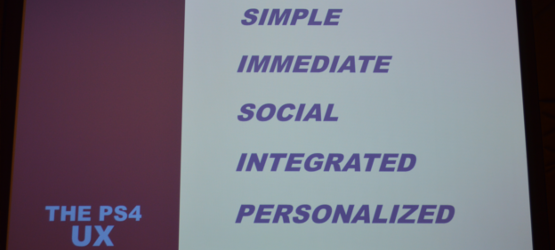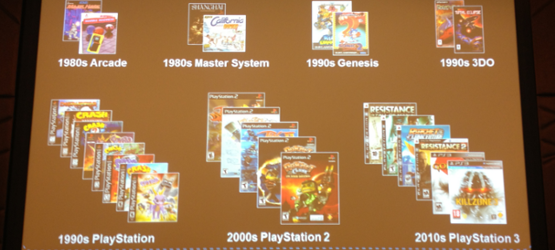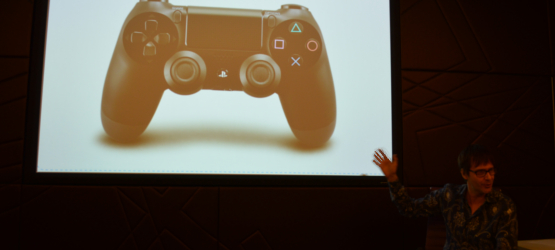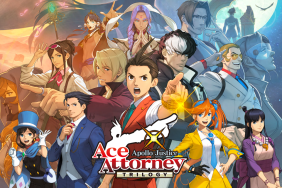We talk to the lead system architect for the PS4, Mark Cerny, in an exclusive, extensive interview. Find out about the console, the DualShock 4, game development, Knack, the Vita and much, much more below.
You’ve talked a lot about the creation of the PS4 in the past. At what point did costs become a factor, because obviously you can always create a better machine for a higher price?
Well, what we do is that we would hash out a break-down plan and look at the costs of each of the components in terms of what we wanted them to do on a feature set level. Really, though, the target was ten times the performance of the PS3. So that pretty much set what we could do financially.
How important do you think it is that the PS4 launches with such a competitive price?
Definitely the consumer is very price conscious, and so one of our main objectives was to create that powerful a system at an accessible price.
What interested me about your talk [at PlayFest] was that you said there are a lot of people who have never played a game. How would you feel if Knack was their first game?
I think if we can bring people from the larger world of games (smart phone and tablet gamers) to console, that would be a beautiful thing. And it being their very first game would be even more beautiful.
Did you build a giant controller for the DualShock 4 as well? [The giant DS3 was built so that they could understand what it was like to be a tiny child]
We did this [holds up giant DualShock 3] two years ago, so no, because it was very hard to make. The factory actually did it for us. Just to get this level of detail, just to get the specs for it, was difficult.
With the DualShock 4, how accessible is the touchpad for children?
The touchpad should be very accessible for anybody. If you use the touchpad you move your hands from the joysticks anyway, while typically with shoulder buttons you’re expected to keep a grip on the joysticks while using them because they’ll do something like aim or strafe, and trying to do something like that requires a certain skill.
At what time did you know that Sony was going to buy Gaikai?
[PR person shakes head] I can’t answer that unfortunately.
[Distracts PR person] But you were obviously doing Remote Play already with the PS3, and probably wanted to do it with the PS4, so you must have had some of that local cloud architecture there…
Yeah, we actually designed the Vita with Remote Play in mind and we knew that with the PS4 that video compression and decompression were vital to have in the hardware. The integration with Gaikai technology to reduce latency did, however, happen very late in the process.

You’ve talked about time-to-triangle [the time it takes a developer to create the base for a game that matches the hardware’s graphical power] and how it can lead to amazing experiences from indie developers. What about the major publishers that are known for producing the same kind of content again and again?
Anecdotally for the indie titles I’ve been hearing 4 weeks to bring a game from PC to the PS4, which is quite fast. For some of the AAA titles I’ve been hearing 2 months, which is also quite fast, and that has really helped us in creating that strong launch line-up.
Is it true that you actually create one level of your game first to see if it’s any fun?
That’s my method, yes. The idea is to create a vertical slice, and it gives you an opportunity to look at what you’re trying to make in a quite polished form – just a little bit of it, and then evaluate whether or not you should continue creating the rest of the game, which of course we did do. Also part of the process is usability testing, in the sense that it’s very important to put your game in front of consumers and see how they do with it: Are they confused? Do they understand their objectives? Do they understand the control scheme?
But then as a creator you have the opportunity to go one of two routes. You can go the route of Braid, which is intentionally a game where every level presents a different challenge, and part of the charm of the game is figuring out what you’re supposed to do each time. At the opposite end of the spectrum is Portal, which had substantial user testing, and as a result they built the game so that each puzzle builds upon the previous puzzle.
While development will be easier, next gen games will obviously have better graphics, better physics, etc. Does that mean rising development costs for the bigger titles?
The accessibility is very good news for title budgets. It means that you can spend more of your time focusing on implementing your vision, and much less on programming in various ways to address details of the hardware.
You’ve talked to a lot of developers and publishers. Was the fact that budgets have doubled and tripled each gen a concern as the PS3 is already at the limit of sustainable development costs?
That was very much part of the feedback we received when we talked to the developers at the beginning of the hardware project. They wanted something that they were familiar with – they also wanted something powerful – but it was important that they could get up to speed on it quickly. They didn’t want exotica, which is to say that -and I was told this directly – that if there was a GPU out there that did real time ray tracing, they would not want it on the hardware because to use that technology would mean throwing out their existing tools and pipelines and rebuilding it all from scratch.
You’ve said that you hadn’t seen the PS4 design until E3, at which point you described it as beautiful. What if it hadn’t been?
[Laughs, pauses]… we have a very good design team.
Was there a little worry?
[Grins] Well I… I was…. curious as to the design process. Design says something as to what the product represents, and to me I feel a little bit of PS2 in there. I feel that return to the past. So it was a real pleasure to see the console.
I’ve gotten a similar sense with the presentations, the videos and the talks that it’s about that return to the past, about bringing back what was right with PlayStation.
PlayStation, as a brand, is very well loved. It’s been a wonderful year, and in many ways we are reconnecting right now with what made PlayStation so special in the first place.
This is the first time two competing platforms have really gone head to head with launches. Is that something you worry about, or do you not really focus on it?
This is just my personal thinking, but I believe that if we have great games, people will come. And so I’m doing whatever I can to make sure that the very strong launch line-up is in place.

You showed a slide of the games you’ve worked on with the PlayStation [above], and with the PS3 you started creating ‘bloodier’ games (Uncharted, Killzone, Resistance). But now you’re going back to a more Crash Bandicoot-style title. Is that what you prefer doing?
I actually enjoy working on first person shooters as well, but I will say that there is a certain fun in getting back to a tight set of core mechanics and using them in a game.
You’ve obviously been very instrumental in the creation and success of Naughty Dog and Insomniac Games. How do you feel about how they’ve developed and grown, and where they are now?
I couldn’t possibly be prouder of Naughty Dog. This is really the second coming in the sense that Jason Rubin and Andy Gavin very much drove that company in the Crash Bandicoot and Jak & Daxter days, but then they left and now we’re seeing Uncharted and The Last of Us which are game of the year titles coming from Evan Wells, Christophe Balestra, Amy Hennig, Neil Druckmann, Bruce Straley and the like.
You’ve been doing back-to-back conferences around the world for the past month – have you had a chance to play The Last of Us?
Yeah, I’m 3 hours in, please don’t tell me how it ends [laughs].
I won’t – it’s good though. So you’re obviously a massive gamer yourself, do you have a PS4 at home?
[Laughs, pauses 10 seconds, looks at PR person] As it stands right now we support development on the PS4, but no consumer unit exists.
You were very involved in making the PlayStation Vita.
Yeah, I had the same responsibilities with the PlayStation Vita as on the PS4.
Were you interested in making a game for it then?
What I found, just personally, was that after the direction we set with the Vita, the PS4 is so much larger a piece of hardware that it absorbed all of my time.

And the PlayStation Camera, were you involved in that?
So the PlayStation Camera and the DualShock 4 were extraordinarily broad collaborations. What we did for the development was we looked at all of the features we could put in a camera or a controller, we went to all the various game teams, and we solicited their feedback about what they were most excited about using in their games. The resulting feature-set of the DualShock 4 and the Camera comes from that. Specifically with regard to the trigger buttons and the joysticks we also designed DualShock 4 to be a more ideal controller for first person shooters. So in order to do that we contacted the best of the best in the genre, both inside and outside of Sony Computer Entertainment, and sent them various prototypes to get their feedback about trigger stiffness, throw distance, position of triggers, joystick accuracy, concavity or convexity of the joysticks, dead spot size and the like.
Wow.
[Grins] The result was definitely a controller that was much closer to the ideal first person shooter controller.
Was that a problem? Because not only do you want it to be ideal for first person shooters, but ideal for other genres too?
It was really nice being at E3 and seeing the reaction to the DualShock 4. Because people have so many years with DualShock, if it is hard to get used to the new controller, then that’s a definite issue. But what we saw was that after just a few minutes they were in the groove, and they were very comfortable with the new controller.
What are your views on the PlayStation Plus requirement for most PS4 online games?
My role is focused on the hardware inside the console, and the larger user experience (simplicity, immediacy and the like). Issues such as PlayStation Plus are handled by the business side of the organization. But I saw the reaction to PlayStation Plus, which was pretty immediate acceptance that this would be part of the experience going forward. I think that the value of PlayStation Plus was understood.








